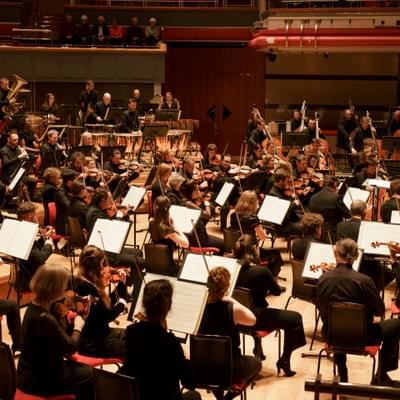Organ Symphony

Full programme
- Ravel, Le Tombeau de Couperin (17mins)
- Poulenc, Organ Concerto (19mins)
- Holmès, Ludus pro patria: La Nuit et l'Amour (6mins)
- Saint-Saëns, Symphony No.3 (Organ) (36mins)
Performers

Pierre Bleuse
Conductor
Thomas Trotter
Organ
Programme Notes
© Lucy Walker
Ravel, Tombeau de Couperin
‘Tombeau’ literally means ‘tomb’, and there is a rich tradition of ‘tombeaux’ in France: artistic works created to honour the dead. In Ravel’s piece, completed in 1917, there is a double honouring taking place. Musically, it harks back to 18th century composer François Couperin and the elegant, refined dance suites of that period. But the work is also a memorial to the more recently fallen. Each movement is named after a friend of Ravel – several of them creative artists - who had died in World War 1. There is, however, nothing deathly or even particularly sombre about the music – as Ravel himself put it ‘The dead are sad enough, in their eternal silence.’
Ravel composed the piece for piano, and later orchestrated it (as was his habit). It has been arranged for other ensembles and individual instruments over the years, but its intricate lines and variety of musical colours are especially well-suited to the organ. The opening Prélude sparkles, and while the second movement is a more academic fugue – each musical line imitating the other in sequence – it has a beautifully meditative quality when played on the organ. The Forlane follows, based on an Italian dance form, and shot through with Ravel’s trademark sensuous harmony. A French dance is next, a Rigaudon, with a carnivalesque ear-worm of a melody and a more reflective central section. The Menuet is Gallic charm itself, while the opening figure of the Toccata ebbs and flows throughout, building eventually to an exhilarating finale – again, making full use of the organ’s potential for high drama.
Poulenc, Organ Concerto
While not an organist himself Poulenc loved to listen to the great French improvising organists, such as fellow composers Duruflé and Dupré, at Saint Sulpice church in Paris. He responded in particular to the theatricality a solo organ recital can have – the sheer volume of the instrument, and its capacity for creating a diverse range of sound worlds. When he was commissioned in 1934 to write an organ concerto by the wealthy Princesse de Polignac, the original idea had been for a modest work of reasonably small proportions. But Poulenc rather ran amok with brief, leaning in to the drama and the organ’s ability to change the very atmosphere of the performing space.
This is evident from the opening bars: a blistering opening for the organ alone, followed by a quieter, slightly eerie passage, underpinned by an ominous rising figure in the timpani and low strings (this will feature in a big way later in the piece). The opening section continues in the same way, following Poulenc’s customary habit of juxtaposing contrasting themes and moods, sometimes abruptly. The work itself follows this pattern as well. Rather than being arranged into a series of movements, it is a continuous work lasting some 23 minutes divided into seven sections, each indicated by an expression mark. For example, the opening Andante is followed by a bustling Allegro giocoso, which comes to a screeching halt after two minutes, followed by the expression mark ‘Subito [suddenly] andante moderato’, leading to a longer, much more peaceful passage. Towards the end of this section, however, is one of the most blood-curdling passages of the whole work – a recurrence of the sinister rising figure of the opening, building into a kind of hysterical intensity, not unlike the soundtrack to a horror film. The work continues to play out an unsettling dialogue of serene, even spiritual passages, with swathes of surging, powerful music for organ and orchestra. The final section is calmer – as if exhausted – but rallies in the last bars for a discordant rendition of the opening chords. After its 1938 premiere in the Princesse’s salon – which must have been quite the domestic space – the Organ Concerto became one of Poulenc’s most popular works, and it is easy to understand why.
Holmès, La Nuit et l'Amour
Augusta Holmès was a French composer of Irish descent (she was originally named ‘Holmes’, adding the accent on becoming a French citizen). In common with many women composers from the nineteenth century, she struggled to be taken seriously and published a few pieces using a male pseudonym. She was, however, rightly ambitious for herself and for the magnitude of the works she composed, which included operas and orchestral works, and she gained a reputation for composing large-scale works with a political or nationalist nature. ‘La Nuit et l’Amour’ was originally an orchestral interlude in her ‘Ode-Symphonie’ Ludus pro patria (‘Patriotic Games’), for which she had also written the words. It is a lyrical, instantly engaging piece, with a skilfully-handled build to the central unison section. It is marked ‘Andante amoroso’, expressing the full-bloodedly passionate text of the Ode-Symphonie.
Saint-Saëns, Symphony No. 3
Camille Saint-Saëns was not known for his jaunty, effervescent character – he was often prickly, rude and even downright offensive – yet much of his music is buoyant, charming, and full of a bracing optimism. His Symphony no 3 (1886), commonly known as the ‘Organ Symphony’, tracks a course from stormy opening to triumphant conclusion in a radiant C major. It is perhaps no coincidence that he was composing his ever-popular Carnival des Animaux at the same time: its playful atmosphere and creative approach to instrumentation can be heard across the whole Symphony.
The composer was a proud Frenchman, keen to establish a national ‘musique’, and had founded the Société Nationale de Musique with the aim of promoting the music of contemporary French composers. The Symphony’s ‘Frenchness’ can be strongly felt in its elegant melodies and the clarity of the orchestral texture, and in its distinctive use of the organ. Saint-Saëns himself was a well-known organist; on hearing him play, the Hungarian composer Liszt had declared him the best organist in the world (perhaps as a result of this Saint-Saëns dedicated the Symphony to Liszt). Including the organ in a Symphony was an unconventional touch (there is also a part for piano) and the composer was aware it might limit performance possibilities. But, characteristic of Saint-Saëns’ music generally, it both honours tradition and provides a fresh perspective to a classical form.
The Symphony is in two movements, each in two contrasting sections. The organist has to wait a while for the big moment, which comes at the start of the final section (though there is an appearance in the Adagio, gently augmenting the orchestral texture). The Symphony starts in a dark place: a hushed opening and agitated first section, which includes the ominous ‘Dies Irae’, or ‘day of wrath’, theme (originally from the plainchant mass for the dead) on the trombones. The substantial Adagio section is warmly lyrical, and for the most part sumptuous and lush, with only a brief moment of disquiet introduced by plucked strings and a hint of the ‘Dies Irae’. The second movement brings back the turbulent atmosphere of the opening, and welcomes the piano – at times requiring an extra player – for some virtuosic capering up and down the keyboard. The triangle and cymbal are then brought to the fore, bringing with them a more festive atmosphere. The organist takes the spotlight in a big way at the start of the concluding section with a gigantic C major chord. With some energetic support from the pianist(s), the organ part gathers in prominence, eventually soaring over the often huge orchestral sound and bringing the work to a joyful conclusion.
Downloads List
Upcoming matinées...
What's on
Katy Jasper-Schmidt
Receptionist
Ruj Sanghera
Membership Manager
Nicole Wood
Assistant Orchestra Manager
Jude Radley
Audience Experience Officer
New faces in the orchestra
24 May 2024